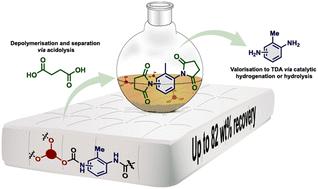当前位置:
X-MOL 学术
›
Green Chem.
›
论文详情
Our official English website, www.x-mol.net, welcomes your
feedback! (Note: you will need to create a separate account there.)
Chemical separation of polyurethane via acidolysis – combining acidolysis with hydrolysis for valorisation of aromatic amines
Green Chemistry ( IF 9.3 ) Pub Date : 2024-06-27 , DOI: 10.1039/d4gc00819g Thomas B. Bech 1 , Bjarke S. Donslund 2 , Steffan K. Kristensen 1 , Troels Skrydstrup 3
Green Chemistry ( IF 9.3 ) Pub Date : 2024-06-27 , DOI: 10.1039/d4gc00819g Thomas B. Bech 1 , Bjarke S. Donslund 2 , Steffan K. Kristensen 1 , Troels Skrydstrup 3
Affiliation

|
As the global production of polymers exceeded 400 million tons in 2022, it is imperative that recycling rates are increased to prevent the predominant end-of-life handling through landfilling and incineration processes. With an increasing reliance on polyurethane (PU), the 2022 global production of PU reached almost 26 million tons. As PU is mainly utilised as a thermoset material, the extensive cross-linked networks render melting and remolding processes known from thermoplastic materials incompatible. As such, the majority of PU that is recycled is processed through mechanical shredding and gluing processes or chemical recycling via glycolysis and acidolysis processes for polyol recovery, all providing a secondary material with properties different from the parent material. Here, we show that the well-established acidolysis process can be used to both depolymerise PU and separate the polyol and dianiline adducts with a specific focus on analysing and valorising the dianiline component arising from the hard segment of PU. By evaluation of the reaction outcome from acidolysis of flexible PU foam with succinic acid, adipic acid or phthalic acid under neat conditions, succinic acid was found to form the corresponding succinimide of toluene diamines that is readily separable from the polyol. The toluene diamine could in turn be reformed through ruthenium-catalysed hydrogenation or simple hydrolysis. Ultimately, the combined acidolysis/hydrolysis of a flexible PU foam yields the polyol and dianiline in a combined 83 wt% recovery. A similar recovery rate was achieved for a commercial rebonded flexible foam. As current PU recycling methods only target the polyol fraction often obtained in a low quality, this advancement shows that current industrially applied acidolysis could be altered so that both the diamines and polyol can be obtained from flexible PU foam. Preliminary results show that the process is applicable to rigid PU foams, a PU fraction that is difficult to recycle due to its molecular complexity. Finally, a mechanistic pathway is suggested to account for the observed product distributions.
中文翻译:

通过酸解化学分离聚氨酯——将酸解与水解相结合以实现芳香胺的增值
到 2022 年,全球聚合物产量将超过 4 亿吨,提高回收率势在必行,以防止主要通过垃圾填埋和焚烧工艺进行报废处理。随着对聚氨酯(PU)的依赖日益增加,2022年全球PU产量将达到近2600万吨。由于 PU 主要用作热固性材料,广泛的交联网络使得热塑性材料的熔化和重塑过程不相容。因此,大部分回收的聚氨酯是通过机械粉碎和粘合工艺进行加工,或通过糖酵解和酸解工艺进行化学回收以回收多元醇,所有这些都提供了具有不同于母材特性的二次材料。在这里,我们表明,成熟的酸解工艺可用于解聚 PU 和分离多元醇和二苯胺加合物,特别侧重于分析和评估来自 PU 硬段的二苯胺组分。通过评估软质聚氨酯泡沫与琥珀酸、己二酸或邻苯二甲酸在纯条件下酸解的反应结果,发现琥珀酸形成相应的甲苯二胺琥珀酰亚胺,很容易与多元醇分离。甲苯二胺又可以通过钌催化的氢化或简单的水解进行重整。最终,软质 PU 泡沫的组合酸解/水解产生多元醇和二苯胺,组合回收率为 83 wt%。商业再粘合软质泡沫也实现了类似的回收率。 由于当前的聚氨酯回收方法仅针对通常以低质量获得的多元醇部分,这一进步表明可以改变当前工业应用的酸解,以便可以从软质聚氨酯泡沫中获得二胺和多元醇。初步结果表明,该工艺适用于硬质聚氨酯泡沫,这是一种由于分子复杂性而难以回收的聚氨酯组分。最后,建议采用机械途径来解释观察到的产品分布。
更新日期:2024-06-27
中文翻译:

通过酸解化学分离聚氨酯——将酸解与水解相结合以实现芳香胺的增值
到 2022 年,全球聚合物产量将超过 4 亿吨,提高回收率势在必行,以防止主要通过垃圾填埋和焚烧工艺进行报废处理。随着对聚氨酯(PU)的依赖日益增加,2022年全球PU产量将达到近2600万吨。由于 PU 主要用作热固性材料,广泛的交联网络使得热塑性材料的熔化和重塑过程不相容。因此,大部分回收的聚氨酯是通过机械粉碎和粘合工艺进行加工,或通过糖酵解和酸解工艺进行化学回收以回收多元醇,所有这些都提供了具有不同于母材特性的二次材料。在这里,我们表明,成熟的酸解工艺可用于解聚 PU 和分离多元醇和二苯胺加合物,特别侧重于分析和评估来自 PU 硬段的二苯胺组分。通过评估软质聚氨酯泡沫与琥珀酸、己二酸或邻苯二甲酸在纯条件下酸解的反应结果,发现琥珀酸形成相应的甲苯二胺琥珀酰亚胺,很容易与多元醇分离。甲苯二胺又可以通过钌催化的氢化或简单的水解进行重整。最终,软质 PU 泡沫的组合酸解/水解产生多元醇和二苯胺,组合回收率为 83 wt%。商业再粘合软质泡沫也实现了类似的回收率。 由于当前的聚氨酯回收方法仅针对通常以低质量获得的多元醇部分,这一进步表明可以改变当前工业应用的酸解,以便可以从软质聚氨酯泡沫中获得二胺和多元醇。初步结果表明,该工艺适用于硬质聚氨酯泡沫,这是一种由于分子复杂性而难以回收的聚氨酯组分。最后,建议采用机械途径来解释观察到的产品分布。


















































 京公网安备 11010802027423号
京公网安备 11010802027423号